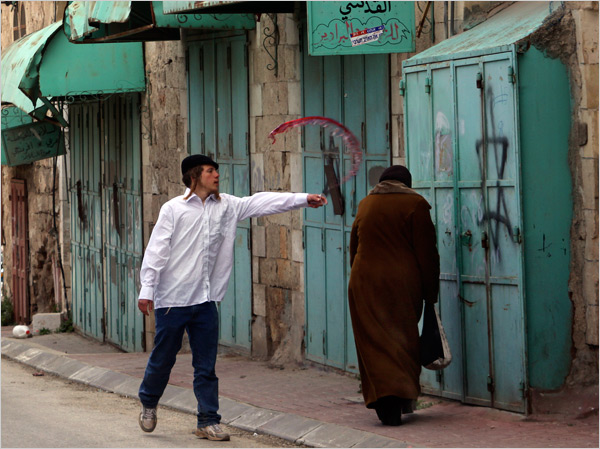Notes
The Practice of Domination in Everyday Life

by contributor Robert Hariman
Amidst the many images of hostility, conflict, and destruction that come out of the occupied territories in Palestine, this one is truly shocking.
The photo appeared on page A8 of the morning edition of the New York Times with this caption:
“Tinderbox In Hebron, a Jewish settler threw wine at a Palestinian woman. The city is a center of tensions between settlers and Palestinians.”
The complete set of images, which included a photo on page 1 of an Israeli child being bathed and three other photos on page 8 labeled “Veneration,” “Remembrance,” and “Preparation,” clearly favored the Israeli settlers. Even so, the photo above gives the lie to the myth of taming the frontier in the Holy Land.
But why does it shock? He is not hitting her, and surely spraying her is less of a crime than, say, razing a house with a military bulldozer. Or blowing up a bus with a suicide bomber. Since there is violence enough on both sides, why make so much of a minor incident of teenage insolence?
I think that there are at least three reasons for the photograph’s impact.
One is that it reveals what is rarely shown: the small acts of personal viciousness and humiliation that make up the practice of domination in an occupied land. Second, it is clear that both the boy’s aggression and the woman’s protective reaction are often-practiced, habitual responses. Were he taunting an older woman for the first time, he would be likely to look much more ragged, uncoordinated, and either furtive or overly demonstrative. Instead, he could be a figure out of Whitman: throwing his weight around without breaking stride, a figure of youthful grace on the city street. Likewise, she isn’t being caught by surprise. Her head is already turned, her body hunched against the impending blow. She’s been through this before, and she’s learned that direct confrontation is not an option. This may be her neighborhood, but it’s his street.
The third dimension of the photograph’s power derives from its capacity for analogy. Look at the woman’s coat and hat, and at the Star of David scrawled on the storefront; she could be in the Warsaw ghetto, and all it takes is a change of costume to see him as a German soldier. Or they could be an African-American woman and a young cracker in the Jim Crow South, or any other tableau that depicts the small details of domination. One picture isn’t enough to nail down such comparisons, but it should make you think of them.
Accompanying story and slide show.
(cross-posted from No Caption Needed.)
(image: Rina Castelnuovo/The New York Times)


Reactions
Comments Powered by Disqus